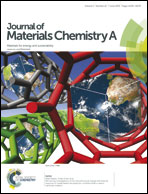Ni@Pd/PEI–rGO stack structures with controllable Pd shell thickness as advanced electrodes for efficient hydrogen evolution†
Abstract
In the present work, nickel (Ni) and palladium (Pd) core–shell structure nanospheres with various thicknesses have been facilely obtained via a one-pot synthesis process. These hybrid structures allow us to correlate the Pd thickness with their performance in the hydrogen evolution reaction (HER). The HER activity increases with a decrease of the Pd thickness, and it can be ascribed to the enhancement of electron donation of Pd (111) caused by the electron flow from Ni (111) to Pd (111) based on first-principles calculations. In this hybrid system, the difference in work functions of Pd and Ni results in surface polarization on the Pd surface, tuning its charge state for hydrogen reduction. Meanwhile, with the assistance of a polyethyleneimine–reduced graphene oxide (PEI–rGO) support, the examined Ni@Pd4:1/PEI–rGO50:1 (10 wt%) electrocatalyst presents outstanding HER activity comparable with that of platinum (Pt). This work opens up possibilities for reducing Pd usage while achieving high HER performance.


 Please wait while we load your content...
Please wait while we load your content...